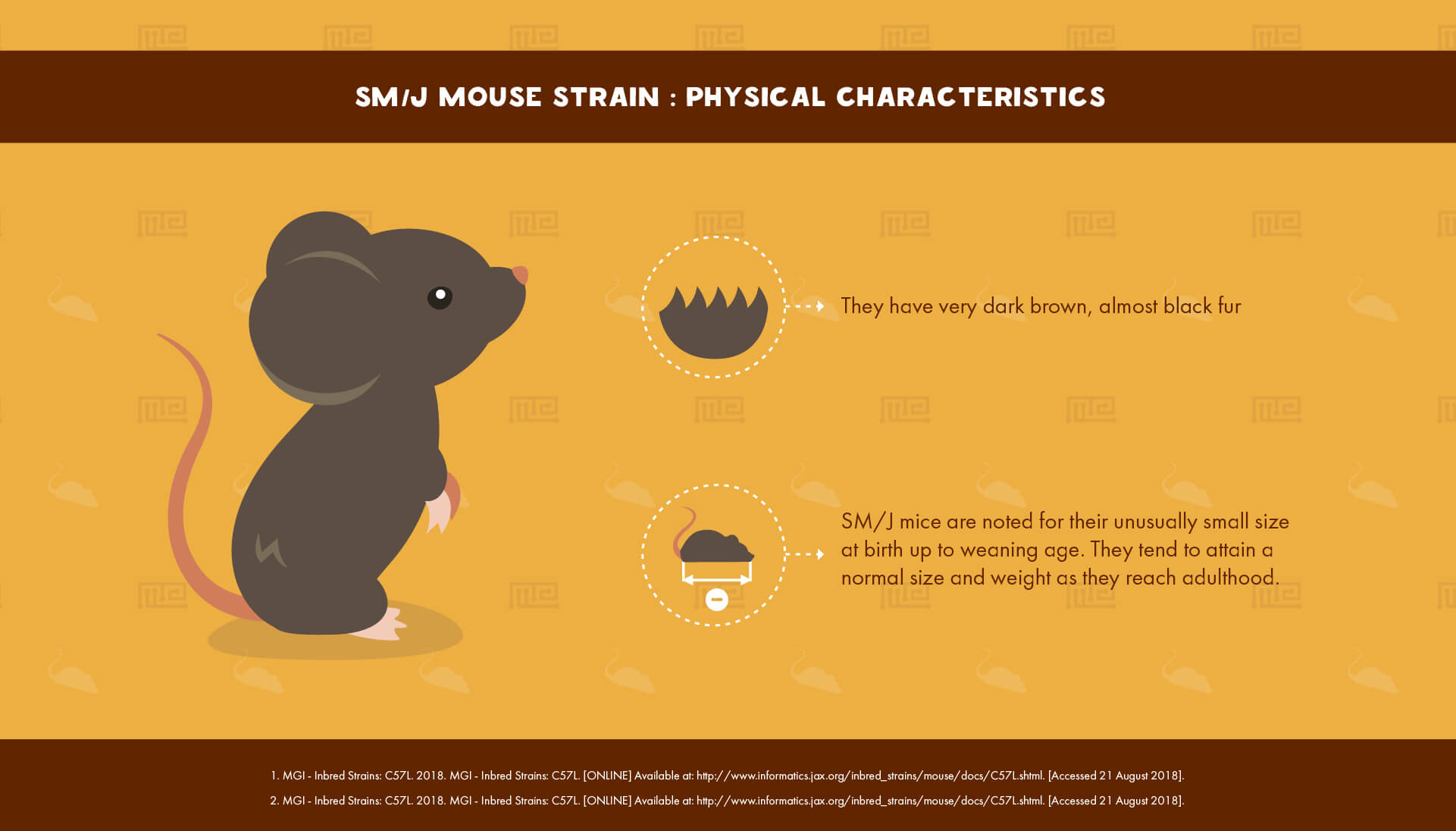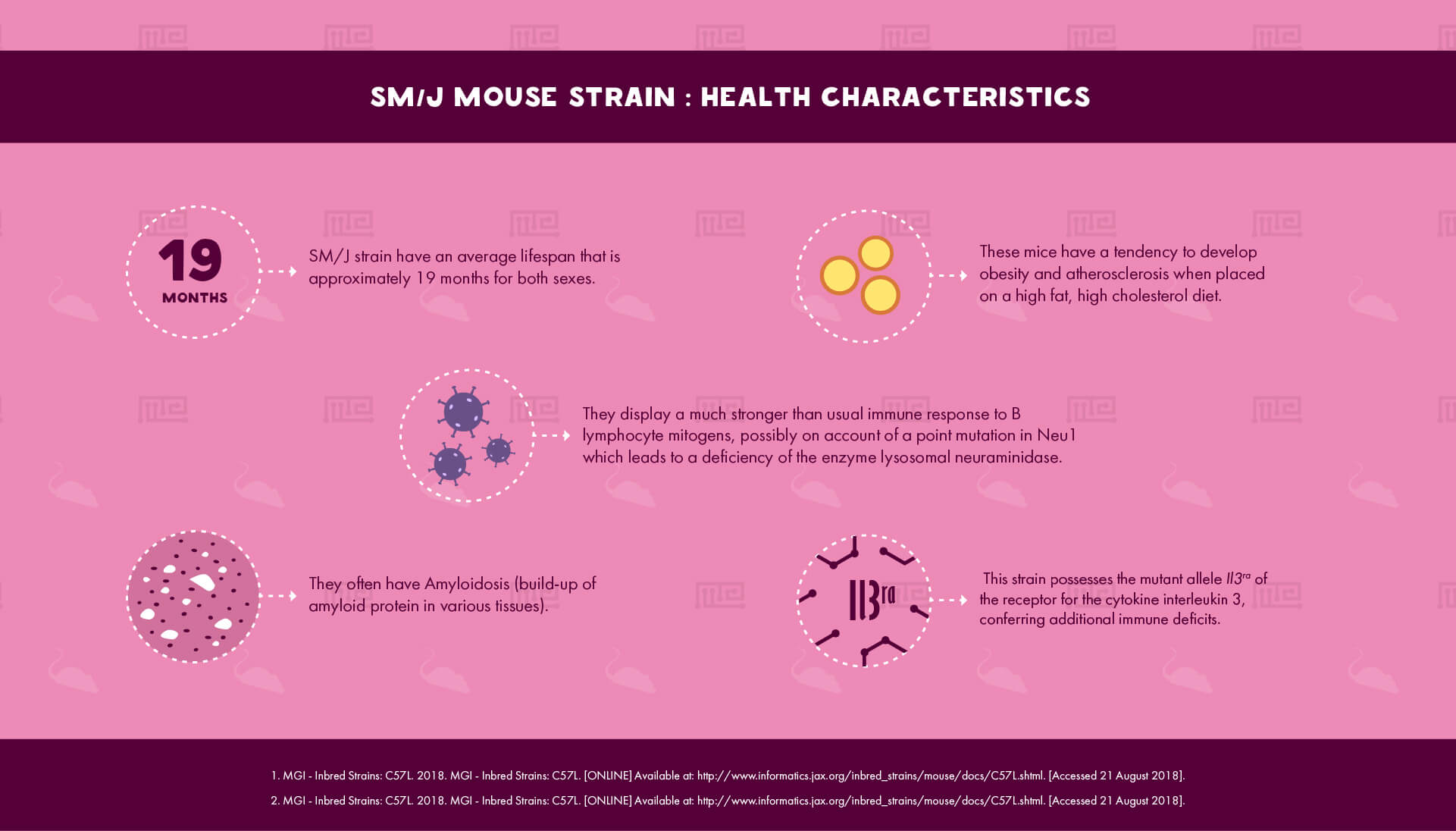Overview
SM/J, also known as “small”, is an inbred strain of mouse model that is noted for its diminutive size at birth. They are frequently used as controls with other strains.
Physical Characteristics
As their alternative name makes clear, SM/J mice are noted for their unusually small size at birth and up to weaning age, although they tend to attain a normal size and weight as they reach adulthood. The smaller size is caused by seventeen different genetic loci, all of which contribute a small effect.[1]
One paper reports that these mice have a large brain for their body size,[3] although another claims that brain size is small in males.[4] They have very dark brown, almost black fur.[2]
Behavioral Characteristics & Handling
A Canadian study[5] comparing the ease of handling of a number of commonly used mouse strains reports that SM/J mice were extremely placid, comparable to A/J and BALB/cByJ. They showed virtually no struggling or squeaking when held, nor any evasive behavior during capture. Experimenters can thus be confident in dealing with mice of this strain.
In one study from 2010,[6] SM/J mice showed the highest immobility of all strains measured in the tail suspension test, whilst also traveling further than average in the open field test. These results suggest the SM/J strain may have a depressive phenotype, with their performance in the open field test ruling out a locomotor explanation for their immobility.
However, another study[7] from 2015 reports that mice of this strain showed low immobility in the forced swimming test, contradicting the prior conclusion. Nonetheless, researchers wishing to employ these paradigms might want to choose a different strain to ensure more reliable data.
Health Characteristics
The average lifespan of the SM/J strain is intermediate (around 19 months), and is approximately the same for both males and females. Tumors are not very common in this strain, although amyloidosis (build-up of amyloid protein in various tissues) is frequently seen.[2] These mice also have a tendency to develop obesity and atherosclerosis when placed on a high fat, high cholesterol diet.[1]
They display a much stronger than usual immune response to B lymphocyte mitogens, possibly on account of a point mutation in Neu1 which leads to a deficiency of the enzyme lysosomal neuraminidase. They also possess the mutant allele Il3ra of the receptor for the cytokine interleukin 3, conferring additional immune deficits.[1]
Major Experimental Uses
SM/J mice are often used in comparative studies with the genetically distinct LG/J or “large” mouse strain which, as its name suggests, displays the exact opposite physical phenotype. This strain is also commonly applied to research on atherosclerosis, developmental defects, diabetes and obesity, and immunodeficiency.[1]
References
- MGI – Inbred Strains: C57L. 2018. MGI – Inbred Strains: C57L. [ONLINE] Available at: http://www.informatics.jax.org/inbred_strains/mouse/docs/C57L.shtml. [Accessed 21 August 2018].
- MGI – Inbred Strains: C57L. 2018. MGI – Inbred Strains: C57L. [ONLINE] Available at: http://www.informatics.jax.org/inbred_strains/mouse/docs/C57L.shtml. [Accessed 21 August 2018].
- Roderick T. H., Wimer R. E., Wimer C. C., and Schwartzkroin P. A. (1973) Genetic and phenotypic variation in weight of brain and spinal cord between inbred strains of mice. Brain Res. 64, 345-353.
- Storer J. B. (1966) Longevity and gross pathology at death in 22 inbred strains of mice. Gerontol. 21, 404-409.
- Wahlsten, D. Metten, P. Crabbe, JC. 2003. A rating scale for the wildness and ease of handling laboratory mice: results for 21 inbred strains tested in two laboratories. Genes, Brain and Behavior. 2; 71-79.
- Miller BH, Schultz LE, Gulati A, Su AI, Pletcher MT (2010) Phenotypic Characterization of a Genetically Diverse Panel of Mice for Behavioral Despair and Anxiety. PLoS ONE 5(12): e14458.
- Moloney RD, Dinan TG, Cryan JF. Strain-dependent variations in visceral sensitivity: relationship to stress, anxiety and spinal glutamate transporter expression. Genes Brain Behav. 2015 Apr;14(4):319-29.


